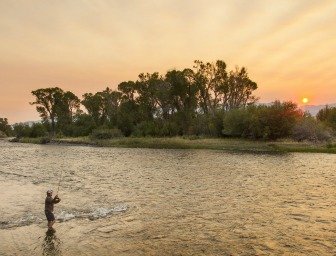Lesser-known rivers offer first-rate fishing
 Every year, trout hunters from around the world flock to Southwest Montana to fish the region’s celebrated waters. The June salmonfly hatch on Rock Creek and the Big Hole River is legendary; the Beaverhead River’s popularity has even necessitated limitations on boat access during prime fishing season.
Every year, trout hunters from around the world flock to Southwest Montana to fish the region’s celebrated waters. The June salmonfly hatch on Rock Creek and the Big Hole River is legendary; the Beaverhead River’s popularity has even necessitated limitations on boat access during prime fishing season.
Yet away from those famed hotspots, fishermen can find equally great fishing — and oftentimes perfect solitude — along other nearby waterways.
The Ruby River springs high in the Gravelly Range of southwest Montana and flows northward through the Ruby Reservoir, eventually reaching its confluence with the Jefferson River at Twin Bridges. Largely situated within private property below the reservoir and in remote backcountry above the reservoir, the Ruby doesn’t offer particularly easy access. What it does offer is great fishing, especially for those willing to hike away from the river’s public access sites. The upper river offers abundant and easy fishing for foot-long rainbow and cutthroat trout, as well as occasional arctic grayling. Below the reservoir, the Ruby is prime brown trout water, with brushy, undercut banks offering protection for fish that sometimes top 20 inches. Easiest access can be found at four public Fishing Access Sites in the nine miles immediately downstream from the reservoir. Access is extremely limited below that. Fly fishermen are reminded to remain below the high-water mark while accessing the river on private property.
Despite feeding into and out of some of Montana’s most revered fishing waters, the Jefferson River gets surprisingly little attention from anglers. The river certainly doesn’t boast the highest concentrations of fish in the region. But with some true behemoths lurking along its grassy banks and with almost non-existent pressure from other anglers, the “Jeff” offers solitude and the benefits it brings: the big fish here aren’t nearly as wary as their cousins in the Beaverhead, Big Hole or other tributaries. Streamer fishing for big browns can be epic if the conditions are right in the upper section between Cardwell and Twin Bridges. Down lower, grasshoppers swarm the river in late summer, making for entertaining dry fly action.
The Missouri River below Holter Dam is one of Montana’s most popular destination fisheries, with enormous trout boiling in dense, shallow-water pods. When they aren’t gorging themselves in the tailwater, many of those trout find their way into the Dearborn River, which flows into the Missouri downstream of Craig. Like the Ruby River, the Dearborn has few public access points; but that just means that hikers can soon find themselves far away from the rod-flailing masses that line the banks of the Missouri, fishing into deep, clear pools that harbor some of Montana’s biggest and hardest-fighting fish. In early summer, lower stretches of the Dearborn can be floated; however, this is technical water with some dangerous drops and rapids. Floaters would do well to carefully read up on the river and check with local guides for conditions. Or, better yet, hire a guide service (there are several in Craig and Wolf Creek).
**
Southwest Montana, formerly known as Gold West Country, is a large swath of mountains, valleys, rivers, lakes and hearty communities smack dab in between Glacier and Yellowstone National Parks. Southwest Montana offers a sampling of all of Montana’s lightly-tread amenities, including mega-mountains, lunker trout, budding melting pots for art and culture in Butte and Helena, remote yet luxurious escapes, and a slice of the Wild West through the numerous and well-preserved ghost towns in its mineral-rich hills. http://goldwest.visitmt.com
Tags: Dearborn River, Grayling fishing, Jefferson River, Montana fishing, Ruby River
